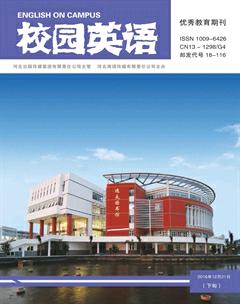The inspiration of American Immersion Teaching Approach on English teaching in China
李晶
【Abstract】As a successful and well-received teaching method, immersion teaching approach has been widely adopted by Canadian and American schools in recent years. With a comparison with traditional English teaching method in China, the author considers the Immersion approach can also be applied for English learning in China.
【Key words】Immersion; World language study;Language environment
The author of this paper had the opportunity to teach in a Chinese Immersion program in an elementary school in South Carolina,US. During her two years teaching period, she carefully observed and adopted the immersion approach,which was well-received by the American primary students. This paper introduces this teaching method and its enlightenments on English teaching in China.
1. Introduction of Immersion Teaching Method
Immersion has been regarded as a revolution to the acquisition of a second language and has been wildly acknowledged as an important and effective approach since its start from Canada in the 1960s. It has become popular and theres a growing trend in recent years that American schools offer immersion programs as an attraction for enrollment. In an immersion program, learners will be totally immersed in the language by learning almost all school subjects, such as math, science and social studies in the target language, with the main purpose of developing learners' language proficiency to the largest extent.
2. Current Status of English Teaching learning in China
English education in China usually starts from grade 3 in elementary schools. But the problem is after more than 10 years of English study, only a tiny portion of the learners have relatively higher language proficiency. The phenomenon of “Deaf English” is still prevalent. The students are asked to parrot and memorize the words and sentences mechanically in traditional English classrooms. They dont have the language environment to fully understand, appreciate ,absorb and apply the language they learn. It turns out that the words and sentences become meaningless and useless. Gradually, the students will lose interest in learning English. while its widely acknowledged that bilingual students with high proficiency of foreign languages and culture is more competitive in this globalized world, changes and transformation in traditional English teaching are irresistible.
3. Different Types of Immersion Programs in America
While most of the schools in China offer only 1-2 hours everyday from grade 3, Immersion school students in America are scheduled to spend approximately 5 hours per day in learning all their major courses in the target language from K-5 or Grade 1-5. In America,since the states or districts have the flexibility on deciding the most suitable mode of teaching,the types of immersion differ greatly from school to school. Some schools apply a half to half immersion. In some cases, the L2 teacher and the English teacher co-teach or rotate in the same class. Some states require 100% immersion, which includes music and PE.Thats to enable the learners totally immersed in a second language environment to the largest extent.
4. Reasons for immersion
4.1 Enhanced language skills
Immersion has proved itself the most effective way to help students attain high levels of second language proficiency. Language environment plays an key role in language learning. Immersion is to provide a language environment most close to their mother tongue learning. Through the immersion process, the learners can not only learn the language itself, but also they can learn the contents of different subjects. With the various science-centered activities or the practical math problem solving, the students basic language skills and cognitive skills have been greatly enhanced. language itself becomes the tool and medium of learning knowledge instead of being the subject. By integrating the contents of subjects, immersion provides a context for language. The students try to think and reflect in the target language. Immersion classes enable language learners to have more exposure to the target language.
4.2 Increased Cultural Sensitivity
Cultural experience is another key ingredient in immersion teaching. Teaching a foreign language is more than teaching the students how to say specific vocabulary, color words for instance. They should know more about the deeper meaning of cultural background. Immersion classes provide various opportunities for the students to experience different cultures from their own.The students have the opportunity to see the world with a broader horizon and more acute insights and prepare themselves more ready to be international citizens.
4.3 Improved intelligence
Immersion enables the learners to grasp the language skills without sacrificing their mastering of knowledge of other subjects. its a good combination and integration of different subjects. Students in immersion classes tend to perform better in both language tests and other tests such as ,ELA test than their peers in non-immersion classes or monolingual students. Thats a proof of enhanced intelligence by dual language learning.
5. Conclusion and Challenges for English immersion teaching in China
Immersion is an effective but a relatively new teaching concept in China.Therere some basic challenges we need to face. To start with, theres a lack of qualified immersion teaching staff and an insufficiency of teaching resources.Immersion program requires more devotion and participation for both the teachers and the students to explain or understand the content. Instead of translating each word or sentence into their native language in traditional classes, immersion requires the students to understand the material in 100% target language. Teachers should have a good command of meaningful input and various teaching strategies such as TPR(Total Physical Response). Teachers tasks are more demanding, for example a large amount of vivid pictures and realia need to be collected in order to help get the meaning across to the students. More support are needed from the education department.Therefore,thorough investigation and careful designing should be carried out further in order to effectively adapt the immersion approach to Chinas English teaching.
References:
[1]袁平華,米保富,胡洁茹.渥太华大学沉浸式双语教育对中国大学英语教学的启示[J].现代教育科学,2011(4).

